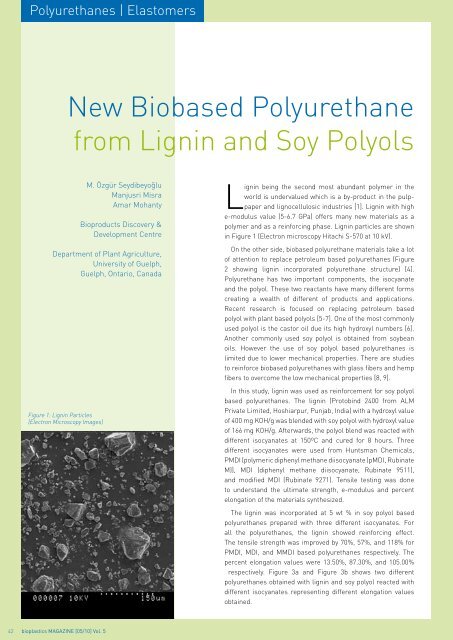05 | 2010
You also want an ePaper? Increase the reach of your titles
YUMPU automatically turns print PDFs into web optimized ePapers that Google loves.
Polyurethanes | Elastomers<br />
New Biobased Polyurethane<br />
from Lignin and Soy Polyols<br />
M. Özgür Seydibeyoğlu<br />
Manjusri Misra<br />
Amar Mohanty<br />
Bioproducts Discovery &<br />
Development Centre<br />
Department of Plant Agriculture,<br />
University of Guelph,<br />
Guelph, Ontario, Canada<br />
Figure 1: Lignin Particles<br />
(Electron Microscopy Images)<br />
Lignin being the second most abundant polymer in the<br />
world is undervalued which is a by-product in the pulppaper<br />
and lignocellulosic industries [1]. Lignin with high<br />
e-modulus value (5-6.7 GPa) offers many new materials as a<br />
polymer and as a reinforcing phase. Lignin particles are shown<br />
in Figure 1 (Electron microscopy Hitachi S-570 at 10 kV).<br />
On the other side, biobased polyurethane materials take a lot<br />
of attention to replace petroleum based polyurethanes (Figure<br />
2 showing lignin incorporated polyurethane structure) [4].<br />
Polyurethane has two important components, the isocyanate<br />
and the polyol. These two reactants have many different forms<br />
creating a wealth of different of products and applications.<br />
Recent research is focused on replacing petroleum based<br />
polyol with plant based polyols [5-7]. One of the most commonly<br />
used polyol is the castor oil due its high hydroxyl numbers [6].<br />
Another commonly used soy polyol is obtained from soybean<br />
oils. However the use of soy polyol based polyurethanes is<br />
limited due to lower mechanical properties. There are studies<br />
to reinforce biobased polyurethanes with glass fibers and hemp<br />
fibers to overcome the low mechanical properties [8, 9].<br />
In this study, lignin was used as reinforcement for soy polyol<br />
based polyurethanes. The lignin (Protobind 2400 from ALM<br />
Private Limited, Hoshiarpur, Punjab, India) with a hydroxyl value<br />
of 400 mg KOH/g was blended with soy polyol with hydroxyl value<br />
of 166 mg KOH/g. Afterwards, the polyol blend was reacted with<br />
different isocyanates at 150ºC and cured for 8 hours. Three<br />
different isocyanates were used from Huntsman Chemicals,<br />
PMDI (polymeric diphenyl methane diisocyanate (pMDI, Rubinate<br />
M)), MDI (diphenyl methane diisocyanate, Rubinate 9511),<br />
and modified MDI (Rubinate 9271). Tensile testing was done<br />
to understand the ultimate strength, e-modulus and percent<br />
elongation of the materials synthesized.<br />
The lignin was incorporated at 5 wt % in soy polyol based<br />
polyurethanes prepared with three different isocyanates. For<br />
all the polyurethanes, the lignin showed reinforcing effect.<br />
The tensile strength was improved by 70%, 57%, and 118% for<br />
PMDI, MDI, and MMDI based polyurethanes respectively. The<br />
percent elongation values were 13.50%, 87.30%, and 1<strong>05</strong>.00%<br />
respectively. Figure 3a and Figure 3b shows two different<br />
polyurethanes obtained with lignin and soy polyol reacted with<br />
different isocyanates representing different elongation values<br />
obtained.<br />
42 bioplastics MAGAZINE [<strong>05</strong>/10] Vol. 5


















